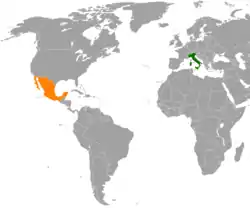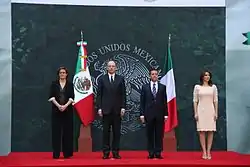Italy–Mexico relations
Italy–Mexico relations refers to the diplomatic relations between Italy and Mexico. Both nations are members of the G20, Organisation for Economic Co-operation and Development and the United Nations.
 | |
Italy |
Mexico |
|---|---|
History
The first contact between Italy and Mexico was in 1869, just before the end of Italian unification in 1870; when Italy expressed its desire to open a consulate in Mexico. An Italian consulate was opened in Mexico in December 1872, however, diplomatic relations between the two nations were not established until 15 December 1874.[1] In 1875, Mexico opened a diplomatic office in Rome.[1]
During World War I, Mexico remained neutral because it was involved in its own revolution during the same time and closed its diplomatic office in Rome. It re-opened its diplomatic office in 1922.[1] In the 1930s, diplomatic relations between the two nations began to deteriorate when Italian Prime Minister Benito Mussolini invaded and annexed Abyssinia (now Ethiopia) during the Second Italo-Ethiopian War in 1935–1936. Mexico was one of the few countries to vehemently oppose the occupation of Abyssinia by Italian forces.[2] During World War II, on 22 May 1942, Mexico declared war on the Axis powers (which included Italy) due to German U-boat attacks on two Mexican oil tankers in the Gulf of Mexico that same year. Diplomatic relations were re-established on 1 June 1946[1] and Italy and Mexico signed a Treaty of Peace on 10 February 1947.[3]
In 1974, President Luis Echeverría Álvarez became the first Mexican head-of-state to visit Italy. In 1981, President Sandro Pertini became the first Italian head-of-state to visit Mexico. Since the initial visits, there have been numerous visits between leaders of both nations. Both nations have signed several bilateral agreements and have worked closely on several projects. In 2014, the Mexican Agency of International Cooperation for Development (AMEXCID) and the Italian Ministry of Foreign Affairs and International Cooperation have collaborated in funding and coordinating 12 research projects in strategic sectors, such as exact sciences, biomedical sciences, environment and energy, agriculture and agri-food, aerospace and technologies applied to cultural goods.[3]
On 17 October 2017, the V Meeting of the Mexico-Italy Binational Commission was held in Rome, headed by the Mexican Secretary of Foreign Affairs, Luis Videgaray and the Italian Minister of Foreign Affairs Angelino Alfano.[3]
High-level visits


High-level visits from Italy to Mexico[4][5][6][7][8]
- President Sandro Pertini (1981)
- Prime Minister Giulio Andreotti (1990)
- President Oscar Luigi Scalfaro (1996)
- Prime Minister Silvio Berlusconi (2002)
- Prime Minister Mario Monti (2012)
- Prime Minister Enrico Letta (2014)
- Prime Minister Matteo Renzi (2016)
- President Sergio Mattarella (2016)
High-level visits from Mexico to Italy[9]
- President Luis Echeverría Álvarez (1974)
- President Carlos Salinas de Gortari (1991)
- President Ernesto Zedillo (1996)
- President Vicente Fox (January and October 2001, 2005)
- President Felipe Calderón (2007, 2009, 2011)
- President Enrique Peña Nieto (2013, 2014, 2015)
Bilateral agreements
Both nations have signed numerous bilateral agreements such as Treaty of General Compulsory Arbitration (1907); Agreement in the Recognition of Consular Marriages Celebrated and Administered in both Nations Diplomatic Missions (1910); Agreement of Cultural Exchanges (1965); Agreement on Air Transportation (1965); Agreement on Technical Cooperation (1981); Agreement on Tourism Cooperation (1991); Agreement on the Avoidance of Double-Taxation and Tax Evasion (1991); Agreement of Cooperation in the Fight against the Misuse and Illicit Trafficking in Narcotic Drugs and Psychotropic Substances (1991); Agreement in Scientific and Technological Cooperation (1997); Agreement in the Promotion and Reciprocal Protection of Investments (1999); Agreement of Cooperation in Combating Organized Crime (2001); Agreement on Mutual Administrative Assistance in Customs Matters (2011); Extradition Treaty (2011) and a Treaty in the Assistance in Criminal Legal Matters (2011).[3]
Transportation
There are direct flights between Italy and Mexico with the following airlines: Alitalia, Blue Panorama Airlines and Neos airline.
Trade
In 1997, Mexico signed a Free Trade Agreement with the European Union (which includes Italy). In 2018, two-way trade between both nations amounted to US$8.3 billion.[10] Italy's main exports to Mexico include: pharmaceutical products; nuclear reactors; boilers; machines, apparatus and mechanical devices; and precious metals. Mexico's main exports to Italy include: vehicles; crude oil; lead minerals and their concentrates; and ethylene polyterephthalate.[3] Italy is Mexico's ninth biggest trading partner globally. Mexico is Italy's second biggest trading partner in Latin-America (after Brazil).[11] Over 400 Italian multinational companies such as Alfa Romeo, Enel Green Power, Eni, Fiat Automobiles, and Pirelli (among others) operate in Mexico. Mexican multinational companies such as Grupo Bimbo and Mexichem operate in Italy.[3]
Resident diplomatic missions
- Italy has an embassy in Mexico City.[12]
- Mexico has an embassy in Rome[13] and a consulate in Milan.[14]
 Embassy of Italy in Mexico City
Embassy of Italy in Mexico City Embassy of Mexico in Rome
Embassy of Mexico in Rome
Country comparison
| Italy | Mexico | |
|---|---|---|
| Flag |  |
 |
| Coat of Arms |  |
 |
| Capital | Rome | Mexico City |
| Largest City | Rome – 2,743,796 (4,300,000 Metro) | Mexico City – 8,918,653 (20,400,000 Metro) |
| Population | 60,317,116 | 128,649,565 |
| Area | 301,340 km2 (116,350 sq mi) | 1,972,550 km2 (761,610 sq mi) |
| Government | Unitary parliamentary republic | Federal presidential constitutional republic |
| First Leader | Victor Emmanuel II (king) Camillo Benso, Count of Cavour (prime minister) |
Agustín I of Mexico (Emperor) José Manuel de Herrera (Prime Minister) |
| Leaders | President: Sergio Mattarella Prime Minister Giuseppe Conte |
President: Andrés Manuel López Obrador |
| Official language | Italian (de facto and de jure) | Spanish (de facto and de jure) |
| Main religions | 83% Roman Catholicism 12.4% Non-Religious Unstated 4.4% Islam, 1.3% Hinduism 0.7% Sikhism 0.4% Judaism 0.4% Buddhism |
83% Roman Catholicism 11% Protestantism 5% Non-Religious 0.2% Other |
| Ethnic groups | Italians | Mexicans |
| GDP (PPP) | $2.443 trillion ($40,470 per capita) | $2.715 trillion ($21,362 per capita) |
| Currency | Euro | Peso |
References
- History of diplomatic relations between Italy and Mexico (Spanish)
- "Diplomatic relations between Italy and Mexico during World War II (Italian)" (PDF). Archived from the original (PDF) on 2014-01-04. Retrieved 2013-06-11.
- Relations between Mexico and Italy (in Spanish)
- "Visita oficial de Estado al señor Oscar Luigi Scalfaro, Presidente de la República Italiana (in Spanish)". Archived from the original on 2018-10-02. Retrieved 2015-03-15.
- President Sandro Pertini visits Mexico (in Spanish)
- "Prime Minister Silvio Berlusconi attends the Monterrey Consensus in Monterrey, Mexico; 2002. (in Spanish)". Archived from the original on 2015-09-23. Retrieved 2015-05-29.
- Letta viaja el lunes a México para reforzar los intercambios comerciales (in Spanish)
- Arriba a México el Primer Ministro Italiano Matteo Renzi (in Spanish)
- Visita ofical a la República Italiana (in Spanish)
- Mexican Ministry of the Economy: Italy (in Spanish)
- Trade between Mexico and Italy (Spanish)
- Embassy of Italy in Mexico City
- Embassy of Mexico in Rome
- Consulate of Mexico in Milan